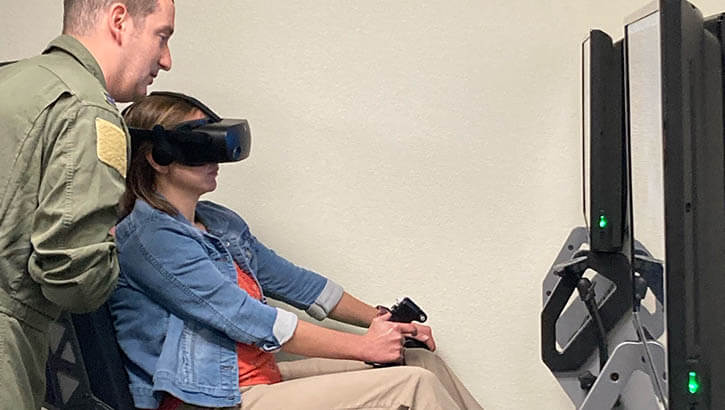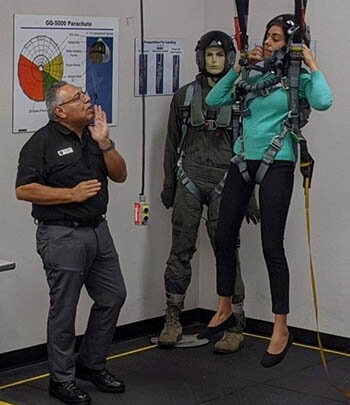Researchers Connect with Warfighters to Guide Tech Development
 Audiologist Dr. Amy Boudin-George, Defense Health Agency Hearing Center of Excellence, Clinical Care Section chief, tries her hand in a T-38 immersive training device at the 560th Flying Training Squadron ("Charging Cheetahs"), Joint Base San Antonio-Randolph, Texas on Dec. 7. The HCE team visited several operational units in December at JBSA, to better understand warfighter hearing and communication needs (Photo by: Elsa Granato, Hearing Center of Excellence)
Audiologist Dr. Amy Boudin-George, Defense Health Agency Hearing Center of Excellence, Clinical Care Section chief, tries her hand in a T-38 immersive training device at the 560th Flying Training Squadron ("Charging Cheetahs"), Joint Base San Antonio-Randolph, Texas on Dec. 7. The HCE team visited several operational units in December at JBSA, to better understand warfighter hearing and communication needs (Photo by: Elsa Granato, Hearing Center of Excellence)
Researchers with the Defense Health Agency's Hearing Center of Excellence are connecting directly with warfighters, to better understand the hearing and balance challenges they experience in an operational environment.
"We're making a concerted effort to 'get out of the clinic' and connect and interact with operational military units in their mission environments," explained Dr. Jeremy Nelson, HCE research branch chief.
The team's first venture outside the clinic focused on pilot training and flight operation activities at Joint Base San Antonio-Randolph on Dec. 7. There they met with staff and pilots from the 560th Flying Training Squadron, 559th MDS Flight Medicine, Aerospace Physiology, and Aircrew Flight Equipment.
"The objective here was to experience some of the noise exposures many of these individuals deal with regularly when performing their missions," said Nelson.
A tour of the 433rd Airlift Wing's C-5 hangar at Joint Base San Antonio-Lackland in Texas early December completed the two-day outreach, where HCE staff got a firsthand look at C-5 flight operations with a tour of the aircraft.
"They demonstrated that hearing and balance health, as well as communication, play important roles in the execution of military training and flight operations," Nelson summed up after the tours. "For these kinds of engagements, the hope is for our team to gain a better appreciation of military flight operations, and how things like movement and noise influence the ability to communicate," said Nelson. "This line-side military engagement was a great success."
 Natasha Gorrell, Defense Health Agency Hearing Center of Excellence, health promotion and education expert, tests out an ejection seat parachute harness trainer at aircrew flight equipment, 12th Operations Group, Joint Base San Antonio-Randolph, Texas on Dec. 7. (Photo by: Elsa Granato, Hearing Center of Excellence)
Natasha Gorrell, Defense Health Agency Hearing Center of Excellence, health promotion and education expert, tests out an ejection seat parachute harness trainer at aircrew flight equipment, 12th Operations Group, Joint Base San Antonio-Randolph, Texas on Dec. 7. (Photo by: Elsa Granato, Hearing Center of Excellence)
According to Nelson, the overall outreach initiative has several distinct functions.
"These activities will help us better understand warfighter missions and issues they encounter in the hearing, balance and communication spaces, and will identify opportunities for HCE to potentially assist with operational or training missions," Nelson explained.
The activities could also serve as a way to talk with service members about hearing protection, overall hearing health, and HCE's mission to reduce noise-induced hearing loss, according to Nelson.
Nelson added the outreach could build a network of potential users interested in advancing technology transition and testing new or novel hearing protection devices.
"These interactions will hopefully influence nearly all activities at the HCE. By building a robust network of operational unit partners, we can more directly solicit feedback on initiatives and capability requirements, develop relationships for future studies, technology development, etc., as well as create awareness of and advocates for our organization," said Nelson.
The future warfighter outreach plan includes additional visits to operational units within the JBSA area, and visits to Fort Hood in Killeen, Texas. The outreach also will eventually leverage HCE's regional research teams across the United States to interact directly with all service branches, according to Nelson.
"Military medicine exists to, first and foremost, support the warfighter," said Air Force Lt. Col. Samuel Spear, HCE branch chief. "If we don't regularly engage with that audience, understanding the missions they perform and the challenges they encounter, there is a much greater chance we will miss the mark in our efforts to 'preserve the fighting force' and 'improve performance.'"